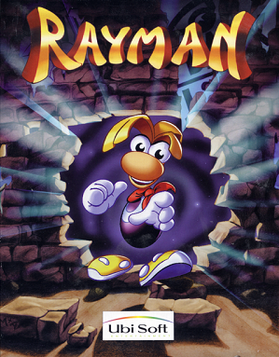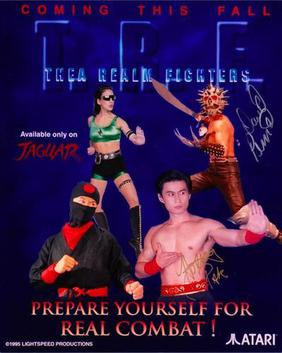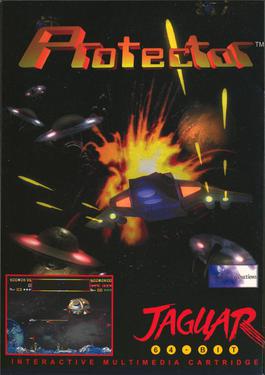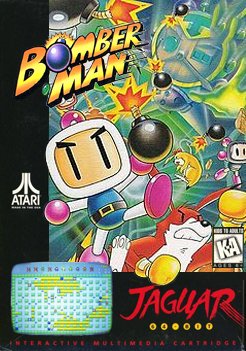
The Atari Jaguar is a home video game console developed by Atari Corporation and released in North America in November 1993. Part of the fifth generation of video game consoles, it competed with the 16-bit Sega Genesis, the Super NES and the 32-bit 3DO Interactive Multiplayer that launched the same year. Powered by two custom 32-bit processors – Tom and Jerry – in addition to a Motorola 68000, Atari marketed it as the world's first 64-bit game system, emphasizing its 64-bit bus used by the blitter. The Jaguar launched with Cybermorph as the pack-in game, which received divisive reviews. The system's library ultimately comprised only 50 licensed games.

The Atari Lynx is a 16-bit fourth-generation hand-held game console released by Atari Corporation in September 1989 in North America and 1990 in Europe and Japan. It was the first handheld game console with a color liquid-crystal display. Powered by a 4 MHz 65C02 8-bit CPU and a custom 16-bit blitter, the Lynx was more advanced than Nintendo's monochrome Game Boy, released two months earlier. It also competed with Sega's Game Gear and NEC's TurboExpress, released the following year.

Rayman is a 1995 platform game developed by Ubi Pictures and published by Ubi Soft for MS-DOS, Atari Jaguar, Sega Saturn, and PlayStation. It is the first installment in the Rayman franchise. The player controls Rayman, who must recapture Electoons and the Great Protoon from Mr. Dark. The gameplay involves rescuing Electoons and gaining new abilities throughout the game.

Kasumi Ninja is a fighting game, developed by Hand Made Software and published by Atari Corporation. Initially it was for the Atari Jaguar in North America and Europe on December 21, 1994, and was later released in Japan by Messe Sanoh in July 1995. It was the first fighting title to be released for the Jaguar, and unsuccessfully sought to capitalize on the trend of ultra violent fighting games started by Midway Games's Mortal Kombat in 1992.

Commander Blood is a science fiction adventure game that was developed by Cryo, a French company that also created Captain Blood. Designed to run on MS-DOS, Commander Blood was released in 1994. The Big Bug Bang, the sequel to Commander Blood, was released in 1996, and was available in French only.

Fight for Life is a 1996 fighting video game developed and published by Atari Corporation in North America and Europe for the Atari Jaguar. It was the final game to be developed and published by Atari themselves before dropping support for the platform and merging with JT Storage in a reverse takeover on July 30, 1996, and the last fighting title released for the console. Set in a purgatory dimension known as the Specter Zone, Fight for Life follows eight deceased fighters as they enter a tournament held by a shapeshifting being called the Gatekeeper, who will bestow a second chance at life to the winner. Its gameplay consists of one-on-one fights, with a main eight-button configuration, featuring special moves and the ability to customize character's movesets, as well as four different playable modes.

Highlander: The Last of the MacLeods is an action-adventure video game developed by Lore Design Limited and published by Atari Corporation exclusively for the Atari Jaguar CD first in North America on 30 October 1995 and later in Europe on November of the same year. The first installment in a planned trilogy based upon Gaumont Television and Bohbot Entertainment's Highlander: The Animated Series, which was both a loose spin-off and sequel of the 1986 film of the same name, players assume the role of Quentin MacLeod in an effort to save the Dundee clan from slavers of the evil immortal Kortan. Its gameplay mainly consists of action and exploration with a main eight-button configuration.

Thea Realm Fighters (TRF) is an unreleased fighting game that was in development by High Voltage Software and planned to be published by Atari Corporation on a scheduled October 1995 release date exclusively for both the Atari Jaguar and the Atari Jaguar CD add-on.

Arena Football '95 is an unreleased arena football video game that was in development by V-Real Interactive and planned to be published by Atari Corporation on a scheduled August 1995 release exclusively for the Atari Jaguar. If it had been released before Midway Games' Kurt Warner's Arena Football Unleashed, it would have been the first officially licensed indoor american football game by the Arena Football League.

Manchester United Europe, developed by Krisalis Software, is the follow-up to the 1990 video game Manchester United which had sold over 100,000 copies. The Atari Lynx port was released under the title of European Soccer Challenge.

Skyhammer is a shooter video game developed by Rebellion Developments and published by Songbird Productions for the Atari Jaguar on May 22, 2000. Its gameplay style is reminiscent of Psygnosis' G-Police for the PlayStation, which was released three years prior to the game.

Protector is a scrolling shooter video game developed by Bethesda Softworks for the Atari Jaguar. The game was released in 1999, with the enhanced edition Protector: Special Edition released in 2002 and the Atari Jaguar CD expansion pack Protector: Resurgence released in 2014. Set in a future where an interstellar war broke out when alien forces arrived on Earth, the player controls the Starblade ship to defeat waves of invading aliens while protecting the inhabitants of Haven-7.

Iron Soldier 2 is an open world first-person mecha simulation video game developed by Eclipse Software Design and published by Telegames for the Atari Jaguar and Atari Jaguar CD on December 30, 1997. It is the sequel to Iron Soldier.

Bomberman Legends, also known as Jaguar Bomberman, is an unreleased action-maze video game that was in development by Genetic Fantasia and planned to be published by Atari Corporation for the Atari Jaguar. It was going to be a unique entry in the Bomberman franchise, featuring its own dedicated single-player and multiplayer modes, with the latter having support for up to eight players by using two Team Tap adapters.

Deathwatch is an unreleased run and gun platform video game that was in development by Data Design Interactive and planned to be published by Atari Corporation on a scheduled December 1995 release date exclusively for the Atari Jaguar. It was the only game in development by DDI for the system.
Legions of the Undead is an unreleased action role-playing video game that was in development by Rebellion Developments and originally planned to be published by Atari Corporation on a scheduled Q3, 1995 release date for the Atari Jaguar. It was also intended to be released for the Windows and PlayStation.

Varuna's Forces is an unreleased sci-fi video game that was in development by Accent Media Productions and planned to be published by Atari Corporation for the Atari Jaguar CD and JVC for 3DO Interactive Multiplayer, Dreamcast, PC, PlayStation and Sega Saturn.



















